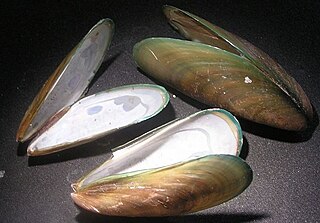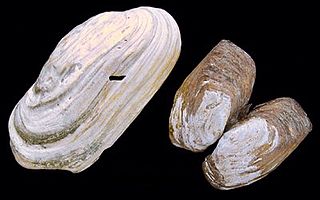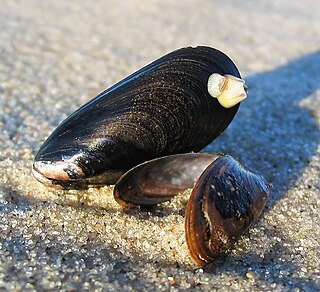
Bivalvia, in previous centuries referred to as the Lamellibranchiata and Pelecypoda, is a class of marine and freshwater molluscs that have laterally compressed bodies enclosed by a shell consisting of two hinged parts. As a group, bivalves have no head and they lack some usual molluscan organs, like the radula and the odontophore. The class includes the clams, oysters, cockles, mussels, scallops, and numerous other families that live in saltwater, as well as a number of families that live in freshwater. The majority are filter feeders. The gills have evolved into ctenidia, specialised organs for feeding and breathing. Most bivalves bury themselves in sediment, where they are relatively safe from predation. Others lie on the sea floor or attach themselves to rocks or other hard surfaces. Some bivalves, such as the scallops and file shells, can swim. Shipworms bore into wood, clay, or stone and live inside these substances.

The Arcida is an extant order of bivalve molluscs. This order dates back to the lower Ordovician period. They are distinguished from related groups, such as the mussels, by having a straight hinge to the shells, and the adductor muscles being of equal size. The duplivincular ligament, taxodont dentition, and a shell microstructure consisting of the outer crossed lamellar and inner complex crossed lamellar layers are defining characters of this order.

The Pteriida are an order of large and medium-sized marine bivalve mollusks. It includes five families, among them the Pteriidae.

The Pteriomorphia comprise a subclass of saltwater clams, marine bivalve molluscs. It contains several major orders, including the Arcida, Ostreida, Pectinida, Limida, Mytilida, and Pteriida. It also contains some extinct and probably basal families, such as the Evyanidae, Colpomyidae, Bakevelliidae, Cassianellidae, and Lithiotidae.

Palaeoheterodonta is a subterclass of bivalve molluscs. It contains the extant orders Unionida and Trigoniida. They are distinguished by having the two halves of the shell be of equal size and shape, but by having the hinge teeth be in a single row, rather than separated into two groups, as they are in the clams and cockles.

Trigonioidea is superfamily of medium-sized saltwater clams, marine bivalve molluscs. Within the fossil record the occurrence of this superfamily is widespread, ranging from the Devonian Period to Recent.

Nuculidae is a family of small saltwater clams in the order Nuculida. Species in this family are commonly known as nut clams.

Mytilida is an order of marine bivalve molluscs, commonly known as true mussels. There is one extant superfamily, the Mytiloidea, with a single extant family, the Mytilidae.

Anomalodesmata is an superorder of saltwater clams, marine bivalve molluscs. This grouping was formerly recognised as a taxonomic subclass. It is called a superorder in the current World Register of Marine Species, despite having no orders, to parallel it with sister taxon Imparidentia, which does have orders.

Hiatellidae is a taxonomic family of saltwater clams, marine bivalve molluscs. This family is placed in the order Adapedonta.

Isognomonidae is a family of medium-sized to large saltwater clams. They are pearl oysters, marine bivalve molluscs in the superfamily Pterioidea

The Pectinoidea are a superfamily of marine bivalve molluscs, including the scallops and spiny oysters.

Protobranchia is a subclass of bivalve molluscs. It contains the extant orders Nuculanida, Nuculida, and Solemyida.

Pectinida is a taxonomic order of large and medium-sized saltwater clams, marine bivalve molluscs, commonly known as scallops and their allies. It is believed that they began evolutionarily in the late Middle Ordovician epoch; many species, of course, are still extant.

Trigoniida is an order of medium-sized saltwater clams, marine bivalve molluscs. Within the fossil record the occurrence of this order is widespread, ranging from the Devonian Period to Recent.

In May 2010, a new taxonomy of the Bivalvia was published in the journal Malacologia. The 2010 taxonomy is known as the Taxonomy of the Bivalvia . The 2010 taxonomy was published as Nomenclator of Bivalve Families with a Classification of Bivalve Families. This was a revised system for classifying bivalve mollusks such as clams, oysters, scallops, mussels and so on. In compiling this new taxonomy, the authors used a variety of phylogenetic information including molecular analysis, anatomical analysis, shell morphology and shell microstructure, as well as bio-geographic, paleobiogeographical and stratigraphic information.
Pinctada longisquamosa, sometimes called scaly pearl osters, are a small species of pearl oyster found in the western Atlantic. They are distinguished by unique prismatic shell structures which protrude from the outer shell.

Ostreoidea is a taxonomic superfamily of bivalve marine mollusc, sometimes simply identified as oysters, containing two families. The ostreoids are characterized in part by the presence of a well developed axial rod. Anal flaps are known to exist within the family Ostreidae but not within the more-primitive Gryphaeidae. The scar from the adductor muscle is simple, with a single, central scar. In the majority, the right valve is less convex than the left.

Mytiloidea are a superfamily of small to large saltwater mussels, marine bivalve molluscs in the order Mytilida.
Lucinida is a taxonomic order of saltwater clams, marine bivalve molluscs.
















